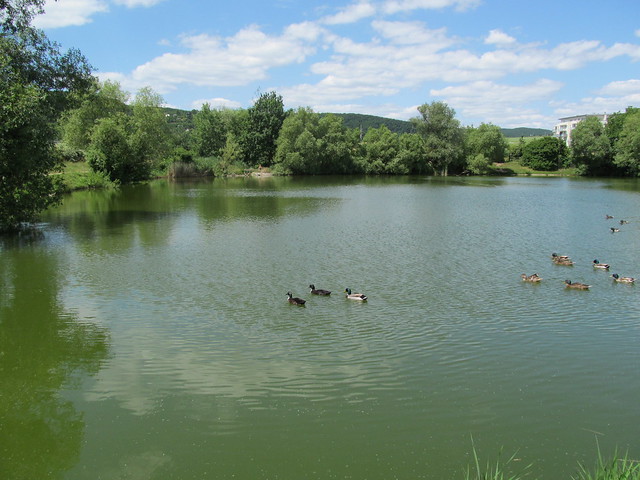We interrupt our completely unscheduled usual talk of sewing and Czech landscape to bring you more Latvian folk costumes!
(It actually ties nicely into the upcoming HSM challenge of "Heirlooms & Heritage", except that the heritage isn't by any means mine...)
You see, there was a festival of amateur folklore ensembles in Prague last week, the Prague Folklore Days, and because my sister speaks Latvian, she was asked months ago to act as a guide and interpreter for Katlakalns, a Latvian ensemble from, you wouldn't guess this, Katlakalns*. :-)
So when they heard I was interested in folk costumes, the ladies gave me a quick fashion show after their performance and I have photos to share.
This first one is probably the most interesting in its "story" - it is the folk costume of
Abrene, nowadays in Russia with a different name (which may still have Latvian roots).
Other than that, it's the style found in Latgale, the eastern part of Latvia, and allegedly (according to that Wikipedia article), in being all white it is the oldest type of Latvian folk costumes. I have a thing for Latgalian folk costumes, as
my last post on my old Czech blog attests.
This one was apparently a little adjusted for the necessities of performance (there was a zipper at the side), but you can still see the typical features - the off-white colour, the red accents, the upturned bottom corners of the bodice, the red embroidered "crown" (worn by unmarried girls throughout Latvia), and the white shirt kept closed with a (more-or-less) circular brooch at the neckline, which is something all Latvian costumes seem to have in common.
These are from Ķekava, i.e. the region/municipality the ensemble comes from. Notice the richly patterned pleated skirt - they make for a lovely sight in movement. :-)
It's also a little bit more typical than the Latgalian one, as you'll see on the following photos. It seems to lie on the border between Zemgale and Vidzeme, so some of the sources I glanced into put it in the one and others in the other (presumably depending on whether you treat the Daugava as the border or not).
This one's from around Rīga; my sister pointed out the metal buttons to me as a feature marking it as a costume from a richer background.
(It's quite fascinating how subtle the differences can be, especially compared to Czech and Moravian folk costumes, where there could be silk brocades and tons of starched petticoats involved... It's another reason I enjoy the Baltic folk costumes - they never cross the line into impractical show-off material.)
Vidzeme (the northern part of Latvia). The pleated, striped skirts and simple bodices continue.
Krustpils. Apparently the border between Vidzeme and Latgale. A plaid twist on the pleated, striped skirts.
This is their fun-loving soloist, in a costume from
Lielvārde. The town is, among other things, renowned for its richly patterned jostas (= the woven belts somewhat typical for Baltic folk costumes). Also, I've visited there, so I'm a little partial. :-)
This costume is from Rucava, a Curonian town relatively near the border with Lithuania. Me and my sister have agreed that it shows in the costume: the green colour is not so typical, the bodice is longer which is more typical for Lithuanian folk costumes than Latvian ones, just like the long ribbons are.
Also, notice the skirt is cartridge-pleated rather than box pleated: that's another distinction I noticed between costumes with patterned skirts and costumes with plain-coloured ones.
To contrast, a costume from Katlakalns itself: richly striped skirt, box-pleated.
Two costumes from
Alsunga. Also Kurzeme / Courland. Cartridge-pleated skirts, decorative trim in the front of the bodice running below waist, metal (brass?) crowns.
Nīca. Kurzeme, typical "jewelled" crown and woven bright red skirt with an irregular pattern (cartridge-pleated).
Bārta. Kurzeme - the same crown, black cartridge-pleated skirt with a patterned bottom and a silver-trimmed red bodice.
(Apparently, normally the shirts of the above two, at the very least, would also be embroidered, which again seems to have been dropped for performance interchangeability.)
And one from Kuldīga, also Kurzeme. Similar to the ones from Alsunga; clearly, there are regional similarities and the costumes are not uniform even in one town or village.
I really liked that this ensemble went with that variety, especially because they happened to be the only Latvian ensemble present, and it went really nicely against the tendency of many other ensembles to be completely uniform in their costumes. Which may make sense from a performance point of view, or because obviously they have their costumes made on order, but it makes it rather limiting if you're looking at them as a representation of their country's culture at an international festival!
Not that I can really hold it against the others, because it was a festival of
amateur ensembles, many of whom probably don't get to represent their country abroad that often.
* * *
Alas, I cannot show you videos of their performance, because my camera tends to switch itself off very quickly when I take videos. So I didn't try that, and there are no videos of their performance on YouTube (yet?).
I do have photos from their performance, not really representative because dance is difficult to photograph. I also have pictures of other ensembles. That's a topic for another post.
* Google has an annoying tendency to assume that the Latvian -s ending is a typo of -a, and forces all the genitive cases on me.


































